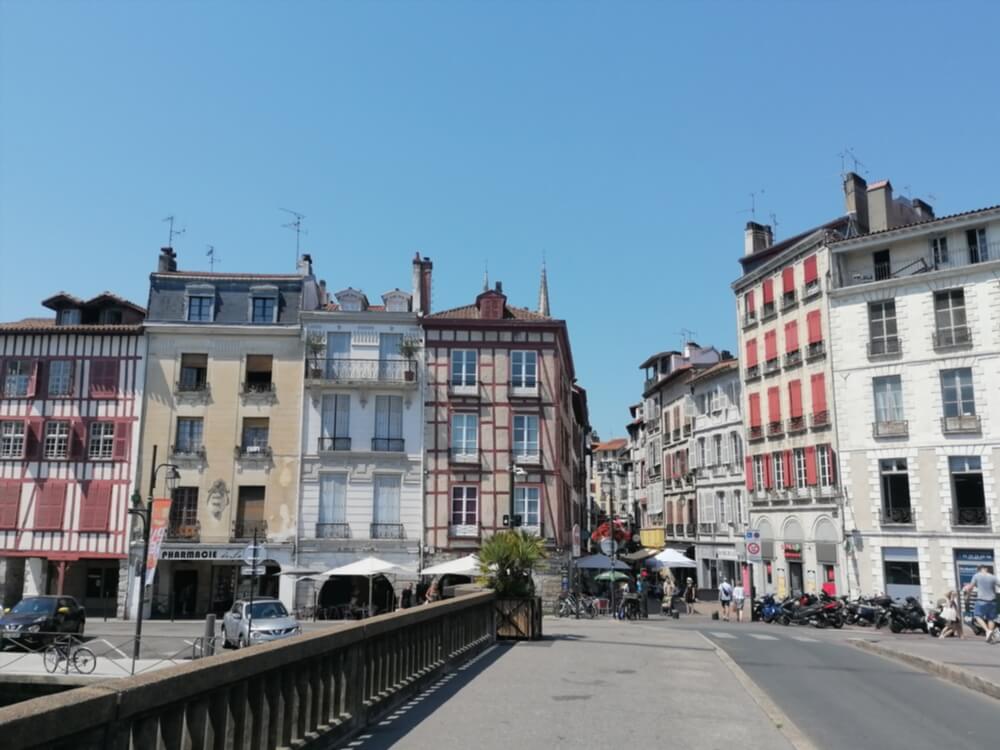Discover the Petit Bayonne district

Bayonne is a city that proudly embraces its Basque roots, and you’ll have the chance to feel that in the charming streets of Petit Bayonne. As well as signs in French and Basque, you’ll find posters and bookshops in Basque, trinquets…
The culture of the region permeates this town steeped in tradition, giving it a distinct personality. It’s a dynamic, young and active place to live. Along the River Nive, which runs through a historic pedestrian zone with numerous fortifications, ramparts and typical colourful facades, you’ll find excellent examples of ancient architecture.
It’s a must-see for families and friends alike, in a district that has benefited from a number of renovations while respecting its Basque identity.
Little Bayonne
- This district is home to the universities and a young student population. Thursday evenings are reputed to be particularly festive in the city of Bayonne!
- Petit Bayonne is also renowned for its historical assets, and in particular its typically medieval little streets and colourful houses, such as rue des Cordeliers. It’s a parade of carefully maintained red and light blue shutters. A camera is a must.
- Most of the Bayonne Festivals take place in the Petit Bayonne area, where the soul of the town is concentrated.
- Busy shops during the day and restaurants and bars synonymous with conviviality when night falls…
The old quarter
Travel back in time by visiting the 16th and 17th century houses. They are located on vaulted passageways built in the medieval period. Because the area was marshy, the houses in the lower town were built on stilts. Take a stroll along Quai des Corsaires and Quai Galuperie to admire these homes with their typical Bayonne style. Numerous historical remains adorn Petit Bayonne, including 13th-century fortifications, the entrance porch to the Château-Neuf, which houses a military heritage, and the neo-Gothic church of Saint-André, which officiates in both French and Basque… A history to discover, a name to remember.
The cultural heritage of Petit Bayonne
The Basque Museum
The museum, which was rebuilt in the early 2000s and now houses a fully renovated museum on three levels, has been wonderfully restored. The ethnographic section is housed in the port warehouses, while the art and history section is on the upper levels of the house.
The 2,000 or so works on display convey aspects of Basque culture, including rural and domestic life, funeral ceremonies, crafts, maritime and river activities, festivals and games, as well as regional history.
Family information: the museum offers tours for families and young visitors.
The Bonnat museum
Bayonne’s Musée des Beaux-Arts houses a valuable collection of paintings, drawings, sculptures, objets d’art and archaeological finds. It was founded thanks to the generosity of Bayonne painter Léon Bonnat.
Rubens, Van Dyck, El Greco, Goya, Ingres, Delacroix, Géricault, Degas, Barye and Bonnat are just some of the great European painters represented in this museum. A real discovery to put on your list.
The graphic arts cabinet contains over 3,500 drawings in perfect condition by Leonardo da Vinci, Michelangelo, Raphael, Durer, Rubens, Rembrandt van Ryncken the Elder (Poussin) and Watteau.
Investment by the City of Bayonne (such as the purchase of the Cailleux collection of terracotta sculptures from the second half of the 18th century), as well as major donations and bequests, have enriched the museum’s holdings. The museum houses around 7,000 pieces (including works by Bonnat in 1922, Personnaz in 1937, Petithory in 1992, and Howard-Johnston in 1989 and 2010).
The Church of Saint-André in Bayonne
The church of Saint-André in Bayonne is home to the work of local painter Léon Bonnat. Built under Napoleon III between 1856 and 1869, it is in the neo-Gothic style, which was very fashionable at the time. The organ dates from 1862, in the Romantic and then Symphonic style, and was listed as a Historic Monument in 2002. The stained glass windows in the Adoration chapel, the paintings by Saint-André and Léon Bonnat are all prestigious objects to be discovered when you visit the church.
The château-neuf du petit Bayonne
Dating from the 15th century, its purpose was to defend the town from Spanish and English attacks. In the 17th century, Vauban improved the capacity of the barracks. It is a 4-cornered defensive building with a round tower built in 1460 to the south-west, a square tower known as the Mocoron tower to the south-east, a 17th-century crenellated curtain wall ending in the 14th-century Mocoron gateway to the north-east, as well as numerous medieval remains. This complex has undergone many changes.
The Saint André trinquet
This is the home of a sport typical of the region: Basque pelota.
200 audioguided tours for cities all around the world
Download

